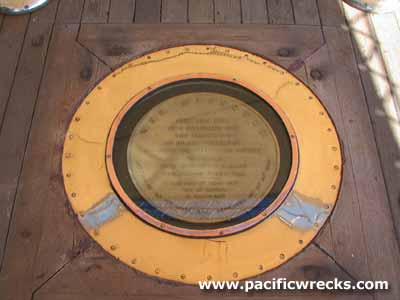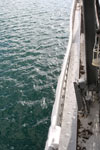|
|
|
| Missing In Action (MIA) | Prisoners Of War (POW) | Unexploded Ordnance (UXO) |
| Chronology | Locations | Aircraft | Ships | Submit Info | How You Can Help | Donate |
|
| USN Iowa-Class Battleship 45,000 Tons (Light) 57,599 Tons (Full Load) 887'3" x 108'3" x 38' Armament (as built) 9 x 16" 50 cal Mark 7 guns 20 x 5" 38 cal Mark 12 guns 80 x 40mm AA guns 49 x20mm AA guns  USN April 11, 1945   USN Sept 2, 1945   USN October 27, 1945    Justin Taylan 2004  Justin Taylan 2010 |
Ship History Built by Brooklyn Navy Yard in Brooklyn, New York. Ordered June 12, 1940 as the third Iowa-Class Battleship ordered but the last to be built. Laid down January 6, 1941. Launched January 29, 1944 as USS Missouri BB-63 named in honor of the State of Missouri. Sponsored by Mary Margaret Truman, daughter of daughter of Harry S. Truman who was then a U.S. Senator for Missouri. Commissioned June 11, 1944 in the U.S. Navy (USN) under the command of Captain William Callaghan. Nicknamed Mighty Mo" or "Big Mo". Departed Brooklyn for sea trials off New York and a shakedown cruise in Chesapeake Bay. On November 11, 1944 departed for Norfolk bound for the Pacific Fleet. On November 18, 1944 transited the Panama Canal then proceeded to San Francisco for final fitting out. Initially, Missouri was painted with dazzle camouflage Camouflage Measure 32, Design 22D but was later repainted gray. Wartime History On December 14, 1944 departed San Francisco and ten days later arrived at Pearl Harbor then departed January 2, 1945 across the Pacific Ocean and arrived eleven days later at Ulithi and became the temporary headquarters for Vice Admiral Marc A. Mitscher. On January 27, 1945 departed Ulithi as part of the screening force for the Task Force 58 (TF-58) including USS Lexington CV-16. On February 1, 1945 anchored at berth #36 at Ulithi loading provisions and carrying out routine work. On February 2, 1945 moved to firing berth Able and conducted anti-aircraft firing aimed at towed target sleeves. On February 10, 1945 at 7:20am got underway for gunnery practice and launched three SC-1 Seahawk floatplanes observation of main and secondary battery surface firing. Shortly after take off, SC-1 Seahawk 35362 piloted by Lt. Everett N. Frothingham developed engine trouble and crashed into the sea and the pilot died before USS Lewis Hancock DD-675 could be rescued. On February 16, 1945 carrier aircraft attacked Japan. Afterwards, Missouri provides gunfire support against targets on Iwo Jima in support of the U.S. Marine Corps (USMC) landing then departed with to Task Force 58 (TF-58). On March 5, 1945 arrived at Ulithi and was assigned to the carrier task group with USS Yorktown and departed nine days later to support carrier aircraft attacks against Japan. On March 18, 1945 took up station off the Inland Sea and as part of the screening force claimed four planes shot down afterwards provided cover for the withdrawal of damaged USS Franklin then proceeded to Okinawa. On March 24, 1945 Missouri was part of the pre-Invasion bombardment of Okinawa until the amphibious landings commenced on April 1, 1945 then joined the screening force for the operation. On April 11, 1945 off Okinawa sixteen enemy aircraft were spotted on radar. One plane, an A6M Zero likely piloted by Ishino Setsuo approached from the stern and although hit by anti-aircraft fire and crashed into the starboard side of the battleship. A famous photo was taken just moments before the aircraft impacted. The plane ricocheted away, causing only minor damage, but the pilot was catapulted from the cockpit, and his body demolished part of a gun mount. The pilot's body landed on the deck and was buried by the ship the next day, with a Marine honor guard firing a salute. A dent in the hull between frames 159 and 165 still remains. Inside a display case are pieces of wreckage from this Zero, believed to be piloted by Petty Officer 2nd Class Ishino Setsuo. On April 17, 1945 detected an enemy submarine 12 miles away and carrier aircraft from USS Bataan and four destroyers were dispatched that resulted in the sinking of Japanese submarine I-56. On May 5, 1945 detached and returned to Ulithi. On August 29, 1945 U.S. Navy (USN) warships with USS Iowa (BB-61) and minesweepers enter Tokyo Bay and anchor off Yokosuka. On September 1, 1945 anchored at berth F 71 in Tokyo Bay and spent the day preparing for the official surrender ceremony scheduled for the next morning. Surrender of Japan On September 2, 1945 at 7:00am the American press corps of 170 newsmen and cameramen on USS Buchanan (DD-484) board Missouri to prepare for coverage of the official surrender ceremony. Next, senior military officers from every Allied nation arrive aboard launches and destroyers. At 8:43am General Douglas MacArthur and Fleet Admiral Nimitz board Missouri. Displayed nearby was a framed U.S. flag flown by Commodore Matthew C. Perry's flagship USS Susquehanna when it entered Edo Bay (Tokyo Bay) on July 8, 1853. At 8:56am the Japanese representatives boarded led by Foreign Minister Mamoru Shigemitsu. At 9:02am General Douglas MacArthur stepped to the microphones and began the twenty-three minute ceremony. The Japanese emissaries signed the instrument of surrender officially ending the Pacific War and World War II. Closing the ceremony, General Douglas MacArthur states: "Let us pray that peace be now restored to the world and that God will preserve it always. These proceedings are closed!" At 9:30am the Japanese representatives departed followed by MacArthur and Nimitz then the senior officers. On October 27, 1945 participates in Navy Day Fleet Review in New York Harbor and fires a salute with one of her 5" guns. During the ceremonies, USS Renshaw (DD-499) delivers U.S. President Harry S. Truman aboard with Admiral Jonas H. Ingram, Fleet Admiral William D. Leahy, Chief of Staff, and Brigadier General Vaughn to inspect the battleship and the surrender location. Postwar Decommissioned in 1955 and returned to service. Again decommissioned in 1991. In 1996 she was towed to Pearl Harbor for permanent display moored off Ford Island. USS Missouri as Museum Open to visitors with paid admission from the USS Missouri Memorial Museum. The ship forms the bookend of WWII Naval history, permanently moored at Battleship Row, to the side of the USS Arizona Memorial. Although the battleship was modernized during the 1980's the flying bridge controls are the same as those used in WWII. Memorials A brass historical marker is located on the deck at the site of the official surrender of Japan on September 2, 1945. Today, the plaque is covered with a porthole cover to protect the plaque. References NARA USS Missouri War Diary - July 24-31, 1944 NARA USS Missouri War Diary - September 1944 NARA USS Missouri War Diary - October 1944 NARA USS Missouri War Diary - November 1944 NARA USS Missouri War Diary - December 1944 NARA USS Missouri War Diary - January 1945 NARA USS Missouri War Diary - February 1945 NARA USS Missouri War Diary - March 1945 NARA USS Missouri War Diary - April 1945 NARA USS Missouri War Diary - May 1945 NARA USS Missouri War Diary - June 1945 NARA USS Missouri War Diary - July 1945 NARA USS Missouri War Diary - August 1945 NARA USS Missouri War Diary - September 1945 Naval History and Heritage Command (NHHC) Tokyo Bay: The Formal Surrender of the Empire of Japan, USS Missouri, 2 September 1945 NavSource - USS Missouri BB-63 (photos) AP Images - WWII Japan Surrender 686883055949 Battleship Missouri Memorial official website Contribute
Information Last Updated
|
Photo Archive |
| Discussion Forum | Daily Updates | Reviews | Museums | Interviews & Oral Histories |
|